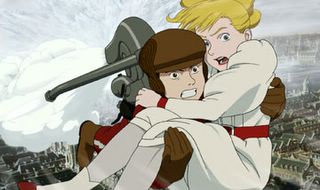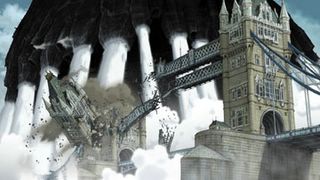It is far too long. It is hard to invest in as a story, as the characters are driven more by ideology than emotion. It adds in so much complex, unexplained backstory that the viewer becomes overwhelmed. It is talky and repetitive.
And yet, I found the movie absolutely gripping, a visual marvel with a brain and an eye for detail. This is one of those anime films that manages to overcome some of the inherent weaknesses of the genre through a combination of tremendous imagination and beautiful, expressive animation.

The first thing you notice about Steamboy, aside from its eye-popping combination of traditional 2D animation along with CG images, is that it's far more detailed and intelligent than any of its American animated counterparts. Even in clever, adult-friendly American toons like The Incredibles, you don't get this level of period detail, you don't get heady concepts involving alternate history and the interplay between huamnity and the technology it creates. This is an animated film that uses the technique not just to entertain kids and impress adults, but to truly create a fanciful scenario purely from scratch, to tell a story that wouldn't work in any other genre.
The film opens in the year 1866. Steamboy relates the story of the appropriately-named Steam family. Grandfather Lloyd Steam (Katsuo Nakmura, and Patrick Stewart in the English dub I didn't watch) has invented a device called a Steam Ball, capable of containing an unlimited amount of compressed energy in an extraordinarily small space.
Obviously, this opens up an entire world of possibilities. Because steam energy was so hard to create, and required tremendous boilers to process, its various uses were limited. It could power a locomotive, sure, but could you ever contain enough steam to run an airplane? Or to run every device in a modern office building?
Unfortunately, the charitable foundation that has funded Lloyd's work, The O'Hara Foundation, wants to use the steam ball to create massive armies, including locomotives that run on tank treads, flying machines, steam-powered robot soldiers and individual-seat submarines. Along with Lloyd's own son, Eddie (Masane Tsukayama), they plan to demonstrate the colossal power of their steam army during an upcoming Science Exhibition in London.
Eventually, the task of stopping the deranged Eddie and the greedy capitalists of O'Hara will fall to Lloyd's grandson, the plucky Ray Steam (Anne Suzuki in the original, Anna Paquin in the USA version). Once the film gets through this initial set-up, at around the 20 minute mark, all hell essentially breaks loose. The bulk of this film is a tremendous chase sequence, in which Ray and the steam ball are pursued over land, sea and air, from a wondrously-realized period Manchester, all smokestacks and grime, to a glorious, mythically oversized London. It works marvelously, and is fantasitcally innovative and exciting.
Otomo should really have been the one to adapt Alan Moore's "League of Extraordinary Gentleman" series. The film that was made was utterly tone-deaf, and had no indication of Moore's obsessive fondness for its setting. Steamboy on the other hand shares a fascination with the detailed inner-workings of Victorian London. Every contraption in the film, from Lloyd's steam ball to a jet pack to gear-based artificial limbs to an enormous Steam Tower capable of blasting off like a rocket, has been designed thoughtfully and carefully, with an eye for period detail.

Once the enormous battles are over, and the Steam Tower has blasted off, and the movie seems ready to wind down, it unfortunately gets a little too cerebral. At a full two hours, Otomo's movie clearly could lose 10-15 minutes, and I'd suggest that most of its allegorical meaning is pretty clear before the characters begin pontificating towards the end. Some of the speechifying gets tedious and repetitive, particularly when you consider that Lloyd and Eddie Steam have at least three "final confrontations."
And there is an undeniable coldness to the enterprise. Though his world has been realized with such impeccable craft and care, Ray Steam himself is something of a blank slate. He has no discernable personality that I could identify, short of a desire to do good and a fondness for his grandfather. The romantic subplot between Ray and the heiress to the O'Hara fortune (named, of course, Scarlett) could not be more ridiculous or unconvincing.
So, despite all its many successes, and my overall fondness for the film, Steamboy doesn't quite get up to the level of an Incredibles or the Toy Story films. Those movies are not only technical marvels, but are bursting with a humanity and a sense of humor Otomo's film lacks.

No comments:
Post a Comment